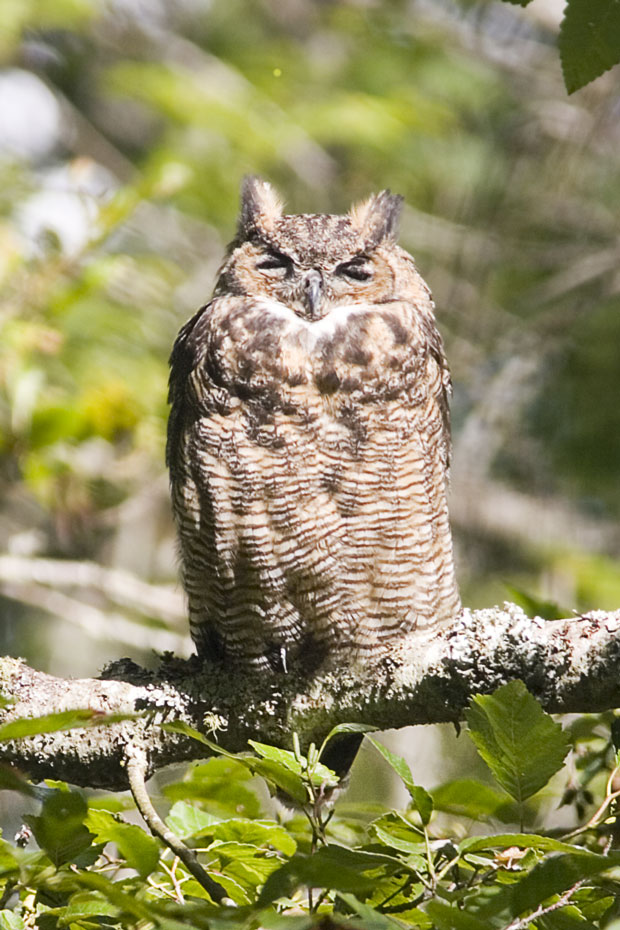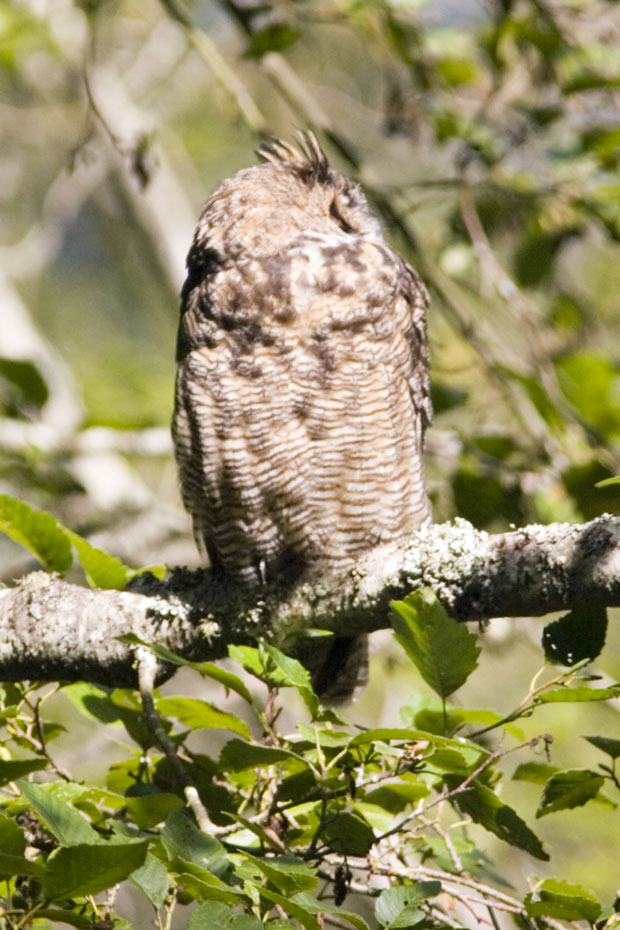I was about to finish my fourth straight trip to Nisqually National Refuge and was thinking that I certainly hadn’t seen many birds today, and, had, in fact, had finally resorted to taking more pictures of Giant Blue Herons.
However, while talking to a couple from the mid-West they informed that there was a Giant Horned Owl up the path a short ways. I picked up the pace, hoping it would still be there when I got there, and, sure enough, there it was sunning himself on a large branch:

I was amazed at how big, and stocky it was, despite the fact that it was several hundred yards away. At first I thought it was sleeping, but when I got home and examined the pictures I had taken I realized he had turned his head completely around while I was talking pictures.

It’s hard not to be reminded of Mary Oliver’s essay entitled “Owls:”
In the night, when the owl is less than exquisitely swift and perfect, the scream of the rabbit is terrible. But the scream of the owl, which is not of pain and hopelessness and the fear of being plucked out of the world, but the sheer rollicking glory of the death-bringer, is more terrible still. When I hear it resounding through the woods, and then the black pellets of its song dropping like stones into the air, I know I am standing at the edge of the mystery, in which terror is naturally and abundantly part of life, part of even the most becalmed, intelligent, sunny life – as, for example, my own. The world where the owl is endlessly on the hunt is the world in which I live too. there is only one world.
In the daytime, I was more awed than cowed, but it was clear that this was a formidable predator, and a rare one in this area. My book lists over 365 local birds, including several other owls, but does not list this species at all, even though Cornell Lab’s Bird Guides says they are found throughout America.

I don’t know much about owls, but this seems like a lovely one to me.
Wow, owls are so hard to spot and harder to photograph.
I used to pass the refuge when we’d go down to my brother’s house for a visit. I didn’t drive at the time and my husband wasn’t much interested in exploring, so I’ve never been there directly. Some day when I visit the Northwest again, I’ll have to make sure to stop by and look for all these birds. And especially the owl.
Thank you Loren for sharing the photos and the words.
Stop by and I’ll drive you down myself, Shelley.
I think you’d love the place, particularly if you did the long, but flat, loop.
The photographs and Mary Oliver’s essay call to mind Richard Wilbur’s lines in ‘The Barred Owl’ pointing out the power of the same words to instill fear or to calm the frightened child:
The warping night-air having brought the boom
Of an owl’s voice into her darkened room,
We tell the wakened child that all she heard
Was an odd question from a forest bird,
Asking of us, if rightly listened to,
“Who cooks for you?” and then “Who cooks for you?”
Words, which can make our terrors bravely clear,
Can also thus domesticate a fear,
And send a small child back to sleep at night
Not listening for the sound of stealthy flight
Or dreaming of some small thing in a claw
Borne up to some dark branch and eaten raw.
By your photos, by Mary Oliver’s prose, by Richard Wilbur’s poetry, by my own memory of looking up at a Great Horned Owl in my previous neighbourhood, I am awed.
I don’t know which is more impressive–your pictures or Mary Oliver’s writing. Together they are awesome.
It also reminds me of a poem by the Japanese poet-recluse Ryokan (1758 – 1831). He often did some quick oriental ink paintings with added haikus or short verses. One of my favorites is of an owl with one eye wide and the other almost closed, and the verse is:
When the
autumn leaves fall,
does this fellow,
too,
feel lonely?
What a great collection of poems about owls, folks.
I guess there’s a richer heritage than I would have ever guessed.